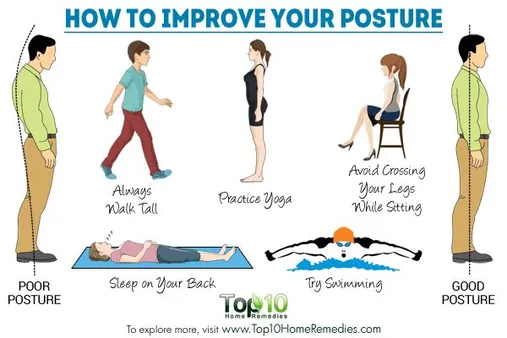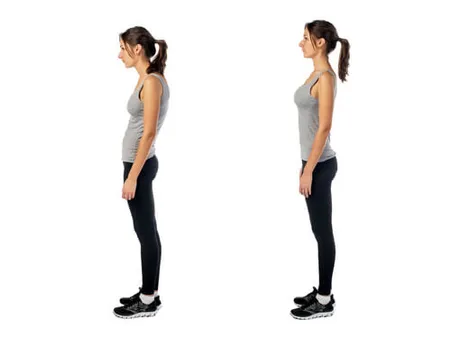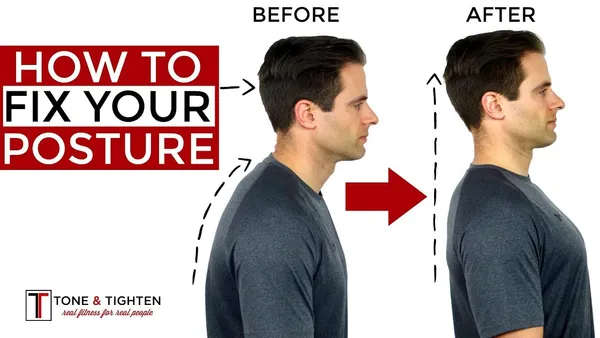Table of Contents
Are you struggling with poor posture? Do you often find yourself slouching or hunching over? If so, you're not alone. Many people suffer from posture problems, which can lead to pain, discomfort, and even long-term health issues. The good news is that there are many things you can do to improve your posture and Kizworld is here to help. In this comprehensive guide, we'll provide you with all the information you need to know about How to improve your posture, including tips for standing, sitting, sleeping, and exercising. We'll also discuss how to manage stress, which can be a major contributing factor to poor posture.
How to Improve Your Posture: Stand Tall and Confident
I. Posture and Its Importance
Posture and Its Importance
What is Posture?
Posture is the way you hold your body when you are standing, sitting, or lying down. Good posture means that your body is in a neutral position, with your spine straight and your muscles relaxed. Poor posture, on the other hand, can lead to pain, discomfort, and even long-term health problems.
Why is Good Posture Important?
Good posture is important for a number of reasons. First, it helps to keep your body in a neutral position, which can help to prevent pain and discomfort. Second, good posture can help to improve your balance and coordination. Third, good posture can help to make you look and feel more confident. Finally, good posture can help to improve your overall health by reducing your risk of developing chronic conditions such as heart disease, stroke, and diabetes.
How to Improve Your Posture
There are a number of things you can do to improve your posture. Here are a few tips:
- Stand up straight with your shoulders back and your head held high.
- Keep your feet shoulder-width apart and your knees slightly bent.
- Tuck your stomach in and tighten your core muscles.
- Avoid slouching or hunching over.
- When you are sitting, make sure your back is straight and your feet are flat on the floor.
- Use a lumbar support pillow to help keep your spine in a neutral position.
- Get regular exercise to help strengthen your core muscles and improve your flexibility.
If you have poor posture, it is important to see a doctor or physical therapist to get help. They can help you to identify the cause of your poor posture and develop a treatment plan to help you improve it.
Improving your posture can have a number of benefits for your health and well-being. By following these tips, you can improve your posture and enjoy the many benefits that come with it.
Here are some additional tips for improving your posture:
- Be aware of your posture throughout the day. If you find yourself slouching or hunching over, correct your posture immediately.
- Take breaks from sitting or standing for long periods of time. Get up and move around every 20-30 minutes to help keep your muscles from getting tight and sore.
- Stretch your muscles regularly. Stretching can help to improve your flexibility and range of motion, which can help to improve your posture.
- Strengthen your core muscles. Strong core muscles help to support your spine and keep your body in a neutral position.
- Wear comfortable shoes. Wearing shoes that are too high or too flat can put strain on your back and neck, which can lead to poor posture.
By following these tips, you can improve your posture and enjoy the many benefits that come with it.
If you are concerned about your posture, talk to your doctor or physical therapist. They can help you to assess your posture and develop a plan to improve it.
Related posts: How to Do a Handstand, The Benefits of Gymnastics for Kids, The Best Gymnastics Equipment for Home Use
II. Causes of Poor Posture
Causes of Poor Posture
There are many factors that can contribute to poor posture. Some of the most common causes include:
- Weak muscles: A lack of strength in the muscles that support your spine can lead to poor posture.
- Tight muscles: Tight muscles in the chest, shoulders, and back can also contribute to poor posture.
- Improper posture habits: Sitting or standing in the same position for long periods of time can lead to poor posture.
- Obesity: Excess weight can put a strain on your muscles and joints, leading to poor posture.
- Medical conditions: Certain medical conditions, such as arthritis and osteoporosis, can also lead to poor posture.
Improving Your Posture
If you are experiencing poor posture, there are a number of things you can do to improve it. Some of the most effective strategies include:
- Strengthening your muscles: Exercise is one of the best ways to strengthen the muscles that support your spine. There are a variety of exercises that you can do to improve your posture, such as:
- Improving flexibility: Stretching is another important part of improving your posture. By stretching the tight muscles in your chest, shoulders, and back, you can help to improve your range of motion and reduce pain.
- Correcting your posture habits: Be aware of your posture throughout the day and make an effort to correct it when you notice that it is poor.
- Losing weight: If you are overweight or obese, losing weight can help to reduce the strain on your muscles and joints and improve your posture.
- Seeing a doctor: If you have a medical condition that is causing poor posture, see your doctor to discuss treatment options.
Benefit | Description |
Reduced pain | Good posture can help to reduce pain in the back, neck, and shoulders. |
Improved breathing | Good posture allows your lungs to expand fully, which can improve your breathing. |
Boosted energy levels | Good posture can help you to feel more energized throughout the day. |
Improved mood | Good posture can help to improve your mood and make you feel more confident. |
Reduced risk of injury | Good posture can help to reduce your risk of injury by keeping your body in proper alignment. |
By following these tips, you can improve your posture and enjoy a variety of benefits. If you have any questions or concerns, talk to your doctor.
Related posts:Benefits of Good PostureHow to Improve Posture at a Desk JobCorrect Posture for Standing and Sitting
III. Methods to Improve Posture
Methods to Improve Posture
Stand Up Straight
- Keep your head up and your shoulders back.
- Your ears should be aligned with your shoulders.
- Your spine should be straight, but not rigid.
- Your stomach should be pulled in and your buttocks should be tight.
- Your knees should be slightly bent.
- Your feet should be flat on the ground, with your weight evenly distributed.
Sit Up Straight
- Choose a firm chair with good back support.
- Sit up straight with your back against the back of the chair.
- Your feet should be flat on the floor, with your knees bent at a 90-degree angle.
- Your arms should be relaxed at your sides.
- Your head should be held high and your shoulders should be back.
The Benefits of Gymnastics for Kids
Sleep on Your Back
- Sleeping on your back is the best position for your posture.
- It helps to keep your spine straight and your head in a neutral position.
- Avoid sleeping on your stomach, as this can put a strain on your neck and back.
- If you have trouble sleeping on your back, try using a pillow under your knees to help support your spine.
The Best Gymnastics Equipment for Home Use
Exercise Regularly
- Exercise can help to strengthen your core muscles, which are important for good posture.
- Exercises that target your back, shoulders, and chest can also help to improve your posture.
- Some good exercises for improving posture include:
- Planks
- Push-ups
- Rows
- Overhead press
- Squats
- Lunges
How to Improve Your Flexibility and Mobility With Gymnastics
Manage Stress
- Stress can contribute to poor posture.
- When you're stressed, your muscles tense up, which can lead to pain and discomfort.
- To manage stress, try relaxation techniques such as deep breathing, yoga, or meditation.
- Getting enough sleep and eating a healthy diet can also help to reduce stress.
The History and Evolution of Gymnastics
IV. Maintaining Good Posture
Maintaining Good Posture
Maintaining good posture is essential for overall health and well-being. It can help to prevent pain, improve balance, and boost mood. There are many things you can do to maintain good posture, including:
- Stand up straight with your shoulders back and your head held high.
- Sit up straight with your back against the back of your chair and your feet flat on the floor.
- Avoid slouching or hunching over.
- Use a pillow that supports your head and neck when you sleep.
- Get regular exercise to strengthen your core muscles.
- Manage stress levels.
If you have poor posture, there are a number of exercises you can do to help improve it. Some of these exercises include:
- Shoulder rolls
- Neck stretches
- Back extensions
- Pelvic tilts
- Glute bridges
- Planks
If you are experiencing pain or discomfort due to poor posture, it is important to see a doctor or physical therapist. They can help you to develop a personalized treatment plan that will help you to improve your posture and relieve your pain.
Maintaining good posture is an important part of a healthy lifestyle. By following these tips, you can help to improve your posture and enjoy the many benefits that come with it.
Here are some additional tips for maintaining good posture:
- Be aware of your posture throughout the day.
- Make small changes to your posture as needed.
- Don't be afraid to ask for help from a friend, family member, or healthcare professional.
- Be patient. It takes time to change your posture.
With a little effort, you can improve your posture and enjoy the many benefits that come with it.
If you are looking for more information on how to improve your posture, check out these related posts:
- How to Improve Your Flexibility and Mobility with Gymnastics
- The Best Gymnastics Exercises for Core Strength
- How to Master the Basic Gymnastics Skills
V. Conclusion
Improving your posture takes time and effort, but it's worth it. Good posture can help you look and feel your best, and it can also help to prevent pain and injury. By following the tips in this guide, you can improve your posture and enjoy all the benefits that come with it.